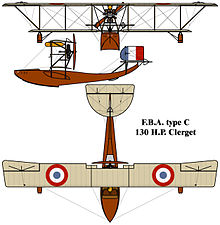Franco-British Aviation (usually known by its initials FBA) was an aircraft manufacturer of the early 20th century, headquartered in London and with its production facilities around Paris.[1] Specialising in seaplanes, it was established in 1913 by Louis Schreck and André Beaumont.
 | |
| Founders | Louis Schreck, André Beaumont |
|---|---|
| Successor | Hydravions Louis Schreck FBA, Société des Avions Bernard |
| Headquarters | London , United Kingdom |
| Products | Military aircraft |
History
The company was established in 1913 by Louis Schreck and André Beaumont.
Louis Schreck was technical director of the French subsidiary in Argenteuil. The first activity of the company was the development of a flying boat hull derived from Donnet-Leveque Type A. The aircraft, a biplane with a single engine mounted between the wings with a pusher propeller, was originally called FBA-Leveque, then it was renamed FBA Type A.
It is from this first model that the manufacturer derived various models that would be used by the forces of Triple Entente: France, United Kingdom and the Russian Empire.
During World War I, the company produced large numbers of small flying boats for the navies of France, Russia, Italy, and the UK.[2]
Following the war, the company was reorganised as Hydravions Louis Schreck FBA as a purely French concern and continued building aircraft in the same class. One of these, the FBA 17, sold in quantity.
In 1922, Émile Paumier became technical director and developed the brand models from the FBA model Type 10. From the Type 19 on, the company abandoned the conventional configuration with pusher propeller to finally adopt the tractor propeller.
The company could not repeat its wartime successes. The lack of orders, especially for civilian models, led to production being stopped in 1931. In 1934, on the verge of collapse, the workshops of the factory were sold to Bernard. Bernard was also struggling and itself failed later in 1935.
Aircraft
| Name | Type | Production | Notes | First flight | Operators |
|---|---|---|---|---|---|
| FBA Type A | Seaplane single engine biplane recognition | Also called FBA-Leveque | 1913 | Austria-Hungary, Brazil, Denmark, France, Italy, Portugal, United Kingdom, Russia | |
| FBA Type B | single engine biplane seaplane | 150 | 1915 | France, United Kingdom | |
| FBA Type C | single engine biplane seaplane | 78+ | 1916 | ||
| FBA Type H | single engine biplane seaplane | 1915 | |||
| FBA Type S | single engine biplane seaplane | 1917 | |||
| FBA 10 | single engine biplane seaplane | 2 | 1922 | ||
| FBA 11 | single engine biplane training seaplane | 1 | Variant of Type C for training | 1923 | |
| FBA 13 | single engine biplane training seaplane | 1 | 1922 | ||
| FBA 14 | single engine biplane seaplane | 20 | Development of Type 11 trainer | France | |
| FBA 16 | single engine biplane seaplane | 1 | |||
| FBA 17 | Single-engine two-seater biplane training seaplane | 348 | Produced under licence in the United States as the Viking | 1923 | Brazil, France, Poland, United States |
| FBA 19 | Amphibian biplane single-engine two-seat reconnaissance | 9 | A prototype version 19 HMT3 3 seater was built | 1924 | |
| FBA 21 | single-engine civil transport amphibious biplane | 7 | Civilianized Type 19 for 4 passengers | 1925 | |
| FBA 171 | Type 17 variant for use on catapult | 1 | |||
| FBA 172 | Type 17 variant for use on catapult | 7 | 1932 | ||
| FBA 270 | Biplane seaplane single engine two-seat | 1 | 1929 | France | |
| FBA 271 | Amphibian biplane single-engine two-seat | 2 | 1930 | ||
| FBA 290 | Prototype amphibious seaplane single engine biplane 4 places | 1 | 1931 | ||
| FBA 291 | Variant prototype amphibious type 290 | 1 | |||
| FBA 293 | Variant of the type 291 – four-seat amphibious liaison | 6 | France | ||
| FBA 294 | Variant of the type 293 – four-seat amphibious liaison | 2 | France | ||
| FBA 310 | amphibious touring monoplane | 9 | 1930 |
References
